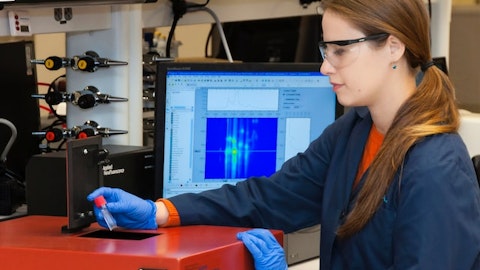In the trial, what we would probably do is try to enrich for those types of biomarkers. So again, the ones I would say would be anything involved in the aurora kinase pathway admittedly, it’s a very broad pathway. There’s a lot of potential ones such as RB1, c-Myc, et cetera. So it is likely we would enrich for those biomarkers and go after a biomarker-focused indication.
Divya Rao: That’s helpful. Thank you. And then one quick question on the live interactions for NERLYNX, how would you, I guess – how close do you think those live interactions are returning to the pre-COVID levels? And then kind of a follow-up on the previous question is that a focus for you guys in terms of increasing promotion primarily? Or are you more focused on the non-personal promotion?
Jeff Ludwig: Divya, I would say a great question. Both, so we want to increase both personal and non-personal, right? Oncology itself is a relatively restricted therapeutic area. And being a small company, it can be more restrictive for us as well. So we want to see an increase in both personal and non-personal. So let me give you some more color there. You asked about live versus virtual we are about 81%, 82% live in this first quarter. We’ve been around that 80% to 85% live versus virtual. I think that mix is going to stay relatively the same. Prior to COVID, we were much higher in the high 90s in terms of live interactions with very limited virtual. We are a smaller company. So our sales teams have large territories. So that’s part of the efficiencies we like.
If you can have an effective and efficient virtual call, that’s one of the ways that I know Ed asked me earlier about being more efficient with travel and spend. If we can have an effective engagement, we’re good increasing both the virtual calls, and we’re also working very hard to increase access around the live calls as well.
Alan Auerbach: Divya, this is Alan. In terms of your question of pre-COVID, remember that pre-COVID, we really didn’t have a lot of the technologies we now have and implementation of those technologies for virtual interactions. So things like Zoom or Teams and things like that, they just really weren’t being used much, which is why Jeff mentioned, most of our pre- COVID interactions was 95%, 97% live. In terms of which one is the focus, as Jeff mentioned in his script, HCP calls, live calls in the first quarter increased 5% quarter-over-quarter. We’re hoping for that number to continue to increase. So in no way, shape or form, are we looking to decrease our live interactions or our personal promotion just looking at it from an investment perspective, which one is more effective and more efficient.
Jeff Ludwig: And the nonpersonal promotion really allows us to cast a very broad net with the hope that it pulls people into some of our live interactions in a very cost-effective manner.
Divya Rao: Got it. Thank you so much.
Operator: And our next question comes from the line of Gena Wang with Barclays. Please proceed with your question.
Unidentified Analyst : Hi. This is Tony on for Gena. Just one quick one on the data for the biomarkers. What should we expect or consider to be a positive signal? And how would this kind of be used in order to for the determined decisions in development.
Alan Auerbach: Yes. Thanks for the question, Tony. You will remember in the small-cell lung cancer trial that was published in the Journal of Thoracic Oncology, specifically in the biomarkers, which was the RB-1, loss function mutation and the c-Myc amplified, it was a randomized trial, so you saw a statistically significant increase in PFS and OS and those biomarkers. That’s something I would consider to be positive. Something where you’re seeing that it differentiates from the rest of the patients. So I would say in this one, they are doing a much more vast biomarker analysis. So I would say anything that kind of rises up, if you will, in terms of either ORR or PFS, showing that you’re getting better activity in patients where there is some biomarker that would suggest that aurora kinase is playing a role in driving that cancer. That’s what we would look to see.
Unidentified Analyst : Got it, thank you.
Alan Auerbach: Sure.
Operator: This concludes our question-and-answer session. And with that, I would like to turn the conference back to Mariann for closing remarks.
Mariann Ohanesian: Thank you all for joining us today. As a reminder, this call may be accessed via replay of the webcast at pumabiotechnology.com beginning later today. Have a good evening.
Operator: Ladies and gentlemen, thank you for participating in today’s conference call. This concludes our program. Everyone, have a great day. You may now disconnect.
Follow Puma Biotechnology Inc. (NASDAQ:PBYI)
Follow Puma Biotechnology Inc. (NASDAQ:PBYI)
Receive real-time insider trading and news alerts


